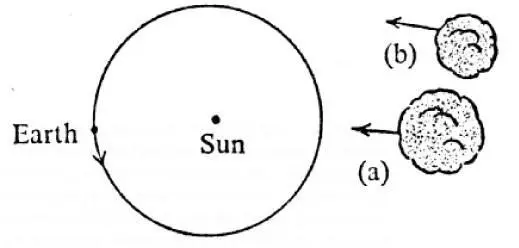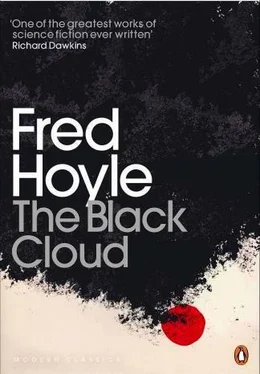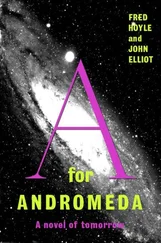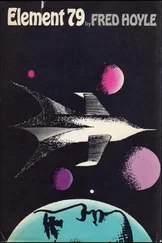Fred Hoyle - The Black Cloud
Здесь есть возможность читать онлайн «Fred Hoyle - The Black Cloud» весь текст электронной книги совершенно бесплатно (целиком полную версию без сокращений). В некоторых случаях можно слушать аудио, скачать через торрент в формате fb2 и присутствует краткое содержание. Жанр: Фантастика и фэнтези, на английском языке. Описание произведения, (предисловие) а так же отзывы посетителей доступны на портале библиотеки ЛибКат.
- Название:The Black Cloud
- Автор:
- Жанр:
- Год:неизвестен
- ISBN:нет данных
- Рейтинг книги:5 / 5. Голосов: 1
-
Избранное:Добавить в избранное
- Отзывы:
-
Ваша оценка:
- 100
- 1
- 2
- 3
- 4
- 5
The Black Cloud: краткое содержание, описание и аннотация
Предлагаем к чтению аннотацию, описание, краткое содержание или предисловие (зависит от того, что написал сам автор книги «The Black Cloud»). Если вы не нашли необходимую информацию о книге — напишите в комментариях, мы постараемся отыскать её.
The Black Cloud — читать онлайн бесплатно полную книгу (весь текст) целиком
Ниже представлен текст книги, разбитый по страницам. Система сохранения места последней прочитанной страницы, позволяет с удобством читать онлайн бесплатно книгу «The Black Cloud», без необходимости каждый раз заново искать на чём Вы остановились. Поставьте закладку, и сможете в любой момент перейти на страницу, на которой закончили чтение.
Интервал:
Закладка:
“We do indeed,” answered the Astronomer Royal. “These photographs are most remarkable. You give the position of the centre of the cloud as Right Ascension 5 hours 49 minutes, Declination minus 30 degrees 16 minutes. That seems to be in excellent agreement with Kingsley’s calculations.”
“Now would you two care to give us a short account of your investigations?’ said Herrick. “Perhaps the Astronomer Royal could tell us about the observational side and then Dr Kingsley could say a little about his calculations.”
The Astronomer Royal gave a description of the displacements that had been discovered in the positions of the planets, particularly of the outer planets. He discussed how the observations had been carefully checked to make sure that they contained no errors. He did not fail to give credit to the work of Mr George Green.
“Heavens, he’s at it again,” thought Kingsley.
The rest of the company heard the Astronomer Royal out with interest, however.
“And so,” he concluded, “I’ll hand over to Dr Kingsley, and let him outline the basis of his calculations.”
“There is not a great deal to be said,” began Kingsley. “Granting the accuracy of the observations that the Astronomer Royal has just told us about — and I must admit to having been somewhat reluctant at first to concede this — it was clear that the planets were being disturbed by the gravitational influence of some body, or material, intruding into the solar system. The problem was to use the observed disturbances to calculate the position, mass, and velocity of the intruding material.”
“Did you work on the basis that the material acted as a point mass?’ asked Weichart.
“Yes, that seemed to be the best thing to do, at any rate to begin with. The Astronomer Royal did mention the possibility of an extended cloud. But I must confess that psychologically I’ve been thinking in terms of a condensed body of comparatively small size. I’ve only just begun to assimilate the cloud idea, now that I’ve seen these photographs.”
“How far do you think your wrong assumption affected the calculations?’ Kingsley was asked.
“Hardly at all. So far as producing planetary disturbances is concerned, the difference between your cloud and a much more condensed body would be quite small. Perhaps the slight differences between my results and your observations arise from this cause.”
“Yes, that’s quite clear,” broke in Marlowe amid aniseed smoke. “How much information did you need to get your results? Did you use the disturbances of all the planets?”
“One planet was enough. I used the observations of Saturn to make the calculations about the Cloud — if I may call it that. Then having determined the position, mass, etc., of the Cloud, I inverted the calculation for the other planets and so worked out what the disturbances of Jupiter, Mars, Uranus, and Neptune ought to be.”
“Then you could compare your results with the observations?”
“Exactly so. The comparison is given in these tables that I’ve got here. I’ll hand them round. You can see that the agreement is pretty good. That’s why we felt reasonably confident about our deductions, and why we felt justified in sending our cable.”
“Now I’d like just to know how your estimates compare with mine,” asked Weichart. “It seemed to me that the Cloud would take about eighteen months to reach the Earth. What answer do you get?”
“I’ve already checked that, Dave,” remarked Marlowe. “It agrees very well. Dr Kingsley’s values give about seventeen months.”
“Perhaps a little less than that,” observed Kingsley. “You get seventeen months if you don’t allow for the acceleration of the Cloud as it approaches the Sun. It’s moving at about seventy kilometres per second at the moment, but by the time it reaches the Earth it’ll have speeded to about eighty. The time required for the Cloud to reach the Earth works out at nearly sixteen months.”
Herrick quietly took charge of the discussion.
“Well, now that we understand each other’s point of view, what conclusions can we reach? It seems to me that we have both been under some misapprehension. For our part we thought of a much larger cloud lying considerably outside the solar system, while, as Dr Kingsley says, he thought of a condensed body within the solar system. The truth lies somewhere between these views. We have to do with a rather small cloud that is already within the solar system. What can we say about it?”
“Quite a bit,” answered Marlowe. “Our measurement of the angular diameter of the Cloud as about two and a half degrees, combined with Dr Kingsley’s distance of about 21 astronomical units, shows that the Cloud has a diameter about equal to the distance from the Sun to the Earth.”
“Yes, and with this size we can immediately get an estimate of the density of the material in the Cloud,” went on Kingsley. “It looks to me as though the volume of the cloud is roughly 1040 c.c. Its mass is about 1·3 × 1030 gm., which gives a density of 1·3 × 10–10 gm. per cm3.”
A silence fell on the little company. It was broken by Emerson.
“That’s an awful high density. If the gas comes between us and the Sun it’ll block out the Sun’s light completely. It looks to me as if it’s going to get almighty cold here on Earth!”
“That doesn’t necessarily follow,” broke in Barnett. “The gas itself may get hot, and heat may flow through it.”
“That depends on how much energy is required to heat the Cloud,” remarked Weichart.
“And on its opacity, and a hundred and one other factors,” added Kingsley. “I must say it seems very unlikely to me that much heat will get through the gas. Let’s work out the energy required to heat it to an ordinary sort of temperature.”
He went out to the blackboard, and wrote:
Mass of Cloud 1.3 × 1030 grams.
Composition of Cloud probably hydrogen gas, for the most part in neutral form.
Energy required to lift temperature of gas by T degrees is 1·5 × 1·3 × 1030 RT ergs
where R is the gas constant. Writing L for the total energy emitted by the Sun, the time required to raise the temperature is 1·5 × 1·3 × 1030 RT/L seconds
Put R = 8·3 × 107, T = 300, L = 4 × 1033 ergs per second gives a time of about 1·2 × 107 seconds, i.e. about 5 months.
“That looks sound enough,” commented Weichart. “And I’d say that what you’ve got is very much a minimum estimate.”
“That’s so,” nodded Kingsley. “And my minimum is already very much longer than it will take the Cloud to pass us by. At a speed of 80 kilometres per second it’ll sweep across the Earth’s orbit in about a month. So it looks to me pretty certain that if the Cloud does come between us and the Sun it’ll cut out the heat from the Sun quite completely.”
“You say if the Cloud comes between us and the Sun. Do you think there’s a chance it may miss us?’ asked Herrick.
“There’s certainly a chance, quite a chance I’d say. Look here.”
Kingsley moved again to the blackboard.
“Here’s the Earth’s orbit round the Sun. We’re here at the moment. And the Cloud, to draw it to scale, is over here. If it’s moving like this, dead set for the Sun, then it’ll certainly block the Sun. But if it’s moving this second way, then it could well miss us altogether.”

KINGSLEY’S DRAWING OF PRESENT SITUATION

Интервал:
Закладка:
Похожие книги на «The Black Cloud»
Представляем Вашему вниманию похожие книги на «The Black Cloud» списком для выбора. Мы отобрали схожую по названию и смыслу литературу в надежде предоставить читателям больше вариантов отыскать новые, интересные, ещё непрочитанные произведения.
Обсуждение, отзывы о книге «The Black Cloud» и просто собственные мнения читателей. Оставьте ваши комментарии, напишите, что Вы думаете о произведении, его смысле или главных героях. Укажите что конкретно понравилось, а что нет, и почему Вы так считаете.












